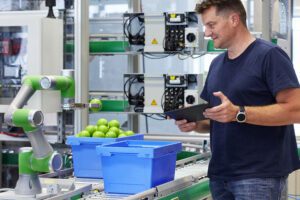
The iron and steel industries are responsible for 9% of global CO2 emissions and are under significant pressure from governments, citizens and many customers to decarbonize their operations. For instance, leading automobile manufacturers demand that steel component suppliers provide them with green steel (steel manufactured without using fossil fuels) to build their cars and trucks. This ultimately lowers their carbon footprint and, hopefully, influences customers’ buying decisions. Read our recent blog to learn how process control technologies contribute to implementing green steel manufacturing approaches.
Technology trends such as electrification and hydrogen production now make it possible for the steel industry to substitute coal for clean energy sources to produce green steel in much larger quantities. According to a recent NGO Global Energy Monitor report, electric arc furnaces account for 31% of current steelmaking capacity.
Regulators also stipulate that green steel production be subjected to a certification process involving accurate measurement and reporting of CO2 emissions. As a result, manufacturers will be aggressively taxed whenever they exceed particular CO2 emissions thresholds.
Both hardware and software technologies enable green steel production
Marketplace trends are radically transforming the way steel companies conduct their business. For example, leading organizations such as Algoma Steel and ArcelorMittal are converting to electrical arc steel-making to reduce carbon emissions by 60% to 70%. They are positioning themselves for long-term growth in the growing green steel market.
Consider the journey of European steel producer Liberty Ostrava, which is in the process of transitioning its operations to expand green steel production by:
- Planning to invest hundreds of millions of dollars over the next eight years to achieve carbon neutrality by 2030.
- Replacing their four traditional coal-fired blast furnaces with two hybrid electric arc furnaces.
- Installing an updated power infrastructure will accommodate hydrogen production and enable the use of a higher volume of steel scrap and a more extensive range of charge materials.
These strategies will reduce the company’s reliance on imported coal and significantly reduce carbon emissions.
However, upgrading furnaces and electrical infrastructure is only part of the steel decarbonization story. The company is also modernizing its automation software in preparation for its rollout of Electric Arc Furnaces (EAF) and Direct Reduced Iron (DRI) process capabilities. The continued deployment of the AVEVA PI System digital platform will allow the steel plant stakeholders to:
- Perform detailed operational analysis.
- Optimize both existing legacy and new systems.
- Implement a real-time, condition-based program for maintenance, process, environmental emissions, energy consumption, etc.
How the new cloud-based automation platform works for sustainable steel
Condition-based maintenance identifies emerging issues and applies fixes before major downtime occurs. It accomplishes this by collecting and analyzing historic and real-time operational data with conditions that reliability engineers already know.
When the platform identifies anomalies, it notifies operators who can take preventative measures to avoid downtime. Besides improving combustion and conversion processes efficiencies, the monitoring system also helps operators optimize raw material usage and energy consumption.
The AVEVA PI System can positively impact operational efficiency and profitability by enabling operators to make better, more accurate decisions. For example, in just one year, system user Liberty Ostrava realized a 10% reduction in production losses and enjoyed a 15% increase in quality, saving hundreds of thousands of dollars per month. As the new EAF and DRI technologies are implemented, these savings can increase exponentially.
The company has also deployed AVEVA digital twin solutions, a cloud-based virtual model that engineers can use to test control logic through operator graphics in a virtual commissioning scenario, minimizing potential errors and streamlining system startup or shutdown processes. In this case, the digital twin offers a visual representation of the electrical and automation aspects of the steel mill, with the ability to take a deeper dive into the blast furnace aspects of the operation. As mentioned, tools like the ETAP digital twin can simulate existing electrical network characteristics and test and measure the impact of changes to a plant’s electrical system without disturbing the live system. Engineers can use both tools to optimize set points using the digital twin while monitoring parameters such as natural gas input or chemical reactions. The result is a reduction in carbon emissions, increased process stability and energy savings.
Furthermore, the AVEVA PI system can consolidate sensor and equipment data, allowing advanced monitoring of vital processes and advanced analysis in near real-time, enabling enhanced maintenance strategies such as predictive and prescriptive maintenance.
For more information
Schneider Electric, AVEVA and ETAP are central to the steel industry‘s decarbonization efforts. We provide sophisticated tools to track CO2 emissions across the entire plant’s lifecycle and support steel manufacturers’ certification efforts. To learn more about accelerating carbon emission reductions and reducing energy costs in steel manufacturing, watch our joint session now.
Contributing author

Geoffrey Scaringella is the ETAP company France & Western Europe Sales & Business Development Director. He was born in Grenoble, France, and graduated from the Grenoble engineering school with an honors degree in Energy science. His previous experience was Senior Power System Engineer, spending many years delivering power system design for the biggest plants in the world.



